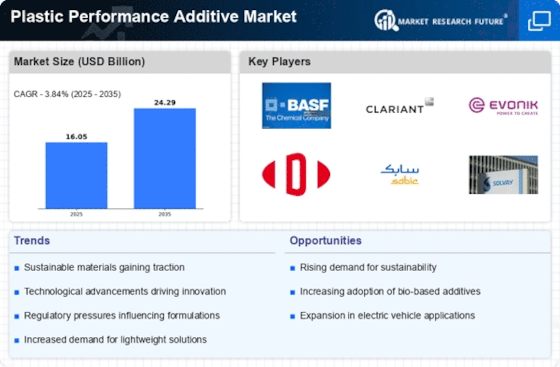Regulatory Compliance
Regulatory frameworks are becoming more stringent, influencing the dynamics of the Plastic Performance Additive Market. Compliance with environmental and safety regulations is compelling manufacturers to adopt additives that meet these standards. This trend is particularly evident in regions with strict environmental policies, where the demand for compliant additives is surging. The market is expected to witness a growth rate of approximately 7% as companies invest in developing additives that align with regulatory requirements. This focus on compliance not only mitigates risks but also enhances the marketability of products, thereby driving growth within the Plastic Performance Additive Market.
Technological Innovations
Technological advancements are playing a pivotal role in shaping the Plastic Performance Additive Market. Innovations in polymer chemistry and processing techniques are enabling the development of high-performance additives that enhance the properties of plastics. For instance, the introduction of nanotechnology in additive formulations is leading to improved strength, durability, and thermal stability of plastic products. The market is witnessing a surge in the adoption of smart additives that respond to environmental stimuli, thereby enhancing functionality. This trend is expected to propel the market forward, with a projected growth rate of around 6% annually as manufacturers seek to leverage these technologies to gain a competitive edge.
Sustainability Initiatives
The increasing emphasis on sustainability within the Plastic Performance Additive Market is driving demand for eco-friendly additives. Manufacturers are increasingly adopting bio-based and biodegradable additives to meet regulatory requirements and consumer preferences. This shift is evident as the market for sustainable plastic additives is projected to grow at a compound annual growth rate of approximately 8% over the next five years. Companies are investing in research and development to create innovative solutions that reduce environmental impact while maintaining performance. As a result, the integration of sustainable practices is not only enhancing brand reputation but also expanding market opportunities for players in the Plastic Performance Additive Market.
Customization and Specialization
The demand for customized solutions is becoming increasingly pronounced within the Plastic Performance Additive Market. As industries such as automotive, packaging, and electronics evolve, the need for specialized additives tailored to specific applications is rising. This trend is reflected in the growing number of companies offering bespoke formulations that meet unique performance criteria. The market is estimated to reach a valuation of USD 5 billion by 2026, driven by the need for enhanced product performance and differentiation. Customization not only allows manufacturers to address specific challenges but also fosters innovation, thereby creating new opportunities within the Plastic Performance Additive Market.
Rising Demand from End-User Industries
The Plastic Performance Additive Market is experiencing robust growth due to rising demand from various end-user sectors, including automotive, construction, and consumer goods. As these industries expand, the need for high-performance plastics that offer enhanced durability, flexibility, and resistance to environmental factors is increasing. The automotive sector, in particular, is projected to account for a significant share of the market, driven by the shift towards lightweight materials for fuel efficiency. This trend is expected to propel the market to a valuation of USD 4 billion by 2025, highlighting the critical role of end-user demand in shaping the future of the Plastic Performance Additive Market.


















Leave a Comment